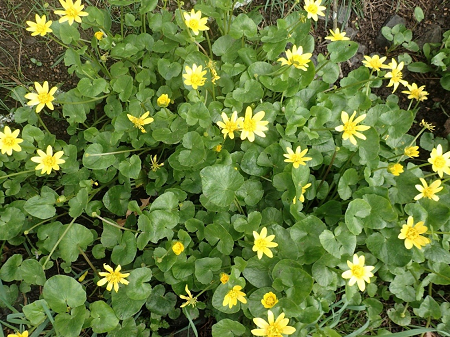Flowers are a sign that spring is here. Their blossoms are a hopeful signal that the long dark days of winter are over and warm weather is soon to come. While their beauty is a welcome sight, some spring flowers are extremely unwanted.
It is no surprise that the Lesser celandine (Ranunculus ficaria) was brought to America as an ornamental plant. Its glossy dark green leaves and bright yellow flowers are beautiful and easy to cultivate. It is one of the first plants to emerge in the spring, making the garden bright and cheery while other plants are still brown and dormant. Unfortunately, this trait makes lesser celandine a menace. It can quickly take over entire lawns, parks, and natural areas. Reproducing from seeds and tubers, mowing and tilling causes it to spread further.
What does it look like? Lesser celandine is a perennial plant in the buttercup family. It is a low-growing plant (no more than 11 inches tall) that spreads to form a thick mat glossy kidney to heart-shaped green leaves. It has eight glossy, butter-yellow petals that sit upon delicate stalks. When in bloom, large infestations appear as a green carpet with yellow dots spreading across the forest floor. The plants only blooms for a few weeks from March to April, then its flowers and leaves quickly wither away.
Why should I care? This attractive plant can quickly wreak havoc in the landscape. Lesser celandine emerges so early that it has already established itself by the time native spring wildflowers and ornamentals are just starting to emerge. It aggressively forms dense patches that prevent growth of native plants and ornamentals by shading and by secreting growth-suppressing chemicals into the soil. It does best in damp areas, but can survive in all kinds of light, moisture, and soil conditions. Lesser celandine is also toxic to most mammals, including humans and livestock.
How do I control it? Lesser celandine is especially difficult to control. It is possible to manage small populations by pulling or digging up the plant and the tubers entirely and disposing them as trash. Don’t leave a bit of the finger-like bulbs behind, or they will establish new plants. Herbicides can be effective for large populations when applied soon after the plant starts flowering. It is critically important to apply according to the label instructions and to only apply in allowed settings.

